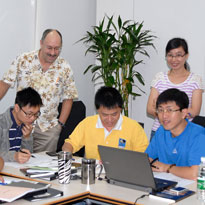Traffic Engineering – Voice/Data
- Course:Traffic Engineering – Voice/Data
- Course ID:TELETRAF Duration:2-3 days Where: Your Office (7+ Persons)
- Download Course Description (PDF)
Available as a private, customized course for your group at your offices or ours and in some cases as a WebLive(TM) class.
Course Outline
- Review of Important Telecommunications Concepts
- Brief history of telecommunications
- Telecommunications systems
- What is capacity?
- What is capacity planning and why is it performed?
- What are trunks?
- What is multiplexing?
- What are trunk groups?
- What are switches?
- What is a class 5, a class 4 switch?
- Overview of packet data networks
- What is a router?
- What is a bridge?
- What is a host?
- Overview of Telecommunications Transport Technologies
- Overview of the T-Carrier system
- Overview of the optical carrier system
- Ethernet
- ATM
- Frame Relay
- Services and Their Traffic Requirements
- Services definitions and resulting traffic types
- Voice and data challenges
- Real-time versus non-real-time applications
- Store and forward/buffering
- Synchronization, delay, and jitter
- Principles of Voice Traffic Engineering
- What is an Erlang?
- Basics of probability and queuing theory
- Randomness
- Erlang B
- Extended Erlang B
- Erlang C
- Basic exercises in using the Erlang tables
- Erlang efficiency curves and relation to trunking
- Optimization exercises for trunk utilization
- Practice traffic engineering exercises: Traffic, blocking, lines
- Principles of Data Traffic Engineering
- Services definitions
- Traffic signatures
- Real-time versus non-real-time
- Bandwidth calculators
- Impact of transmission networks to service assurance
- Correcting for different transmission media to meet bandwidth requirements
- Impact of buffers
- Buffer analysis and planning
- Practice traffic engineering exercises: Services mix, rate of arrival, bandwidth calculations
- Principles of VoIP/Data Engineering
- What is VoIP?
- How does VoIP differ from other applications?
- What are the services requirements of VoIP?
- What other applications are similar, or not similar, to VoIP?
- Traffic simulators overview
- Traffic simulator output and meaning
- Impact of network design, optimization and planning
- Buffer analysis
- Final bandwidth calculations
- Practice traffic engineering exercises: Class of service, QoS, services mix, rate of arrival, bandwidth calculations
- Wrap-up: Course Recap, Q/A, and Evaluations
Course in a Nutshell
Good traffic engineering is important not only in the initial design of a voice or data network but also key to its continued smooth operation. This two-to-three day course provides a sound introduction to the principles of traffic engineering, the exact duration depending on the number and types of transport technologies and services included in the course.
After a quick review of some of the important telecommunications concepts, we will study the transport technologies such as the T-Carrier and optical carrier systems, Ethernet, ATM, and Frame Relay. We will then look at the types of services that may be offered, their characteristics, and the issues unique to each. We will study the models that are used to understand and explain voice traffic, including Erlang A, B, and C, and learn how to apply them properly. We will then study the challenges posed by data traffic, including an in-depth look at VoIP traffic engineering. Upon completion of this course, you will have a good understanding of how to characterize, measure, predict, and optimize telecommunications traffic, both voice and data.
Customize It!
We can customize this course to your specific needs at little-to-no additional cost. This course is also offered in distinct versions tailored for audiences such as:
- Network design, optimization, and traffic engineers
- Equipment or application designers
- Less technical audiences such as managers, executives, business planners, sales and marketing specialists, and operations and support personnel.
Please note that the course content and duration can be tailored to the specific technologies and services of interest to you.
Aimed At
Those who work with telecommunications networks, voice or data, and wish to understand the principles of voice/data traffic engineering.
Prerequisites
At least two years experience in the design and optimization of a telecommunications network using any major transport technology. An engineering degree is desired, but not required. Mathematics background, especially in probability theory, will be helpful.
- "Great course. Enjoyed it immensely. Very well researched. Would like to have him as an instructor again." – B.M., Manager, State of Florida

